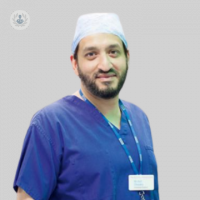What is upper gastrointestinal (GI) surgery?
Upper gastrointestinal (GI) surgery is surgery performed to treat pathologies of either the upper gastrointestinal tract (small bowel), gall bladder, liver, pancreas or oesophagus.

The upper gastrointestinal (GI) includes the oesophagus (the food pipe), the duodenum (the first part of the small intestine) and stomach.
Why is upper gastrointestinal (GI) surgery done?
The upper gastrointestinal tract is vulnerable to several conditions that may need surgical treatment Upper GI surgery can be done as a:
- Oesophagectomy: surgery to treat oesophageal tumours, and it involves removing all or part of the oesophagus.
- Gastrectomy: a surgery to treat stomach tumours. This involves the full or parial removal of the stomach and nearby lymph nodes.
- Minimally invasive laparoscopic (keyhole) surgery: This can be used for resection (removal) of stomach and oesophageal tumours.
A doctor might recommend upper gastrointestinal (GI) surgery if a patient suffers from symptoms including bloating, abdominal pain, heart burn, swallowing difficulties and acid regurgitation. The condition is first evaluated using diagnostic techniques to find the underlying conditions.
Symptoms that may motivate someone to find out if upper gastrointestinal (GI) surgery is right for them may be due to conditions such as:
- Inflammation of the stomach
- Gastritis or duodenum
- A H.pylori infection.
- Gastroesophageal reflux disease (GERD)
- Peptic ulcers (sores)
Other diseases affecting the motility (ability to move) and the function of the oesophagus.
Symptoms can be caused by stomach tumours or oesophageal tumours. Depending on the location and the stage of the cancer, surgery might be needed for the treatment and management of the cancer.
Preparation for Upper GI surgery
There are several diagnostic procedures to evaluate conditions that may need upper GI surgery as treamment, including:
- Upper GI endoscopy , a procedure used to diagnose and treat certain upper GI conditions or problems. It uses special instruments with a laser attachment and camera.
- Oesophageal pH monitoring , this measures how often the stomach acid enters the oesophagus. It is most commonly used to diagnose gastroesophageal reflux disease (GERD).
- Oesophageal manometry is used to assess the function of the sphincter, the muscle at the lower end of the oesophagus.
These diagnostic techniques can be used to evaluate some upper GI symptoms for example:
- swallowing difficulties
- abdominal pain
- benign (non-cancerous) or malignant (cancerous) tumours.
Upper GI surgery aftercare
Post upper GI surgery patients may need someone to help with heavier jobs such as food shopping gardening or vacuuming for a few weeks.
Some patients feel more confident staying with or having a relative or friend stay with them. Patients are often encouraged to do regular, daily exercise in order to stay active. This reduces the risk of blood clots forming in the legs.
03-01-2017 03-01-2017Upper GI surgery
What is upper gastrointestinal (GI) surgery?
Upper gastrointestinal (GI) surgery is surgery performed to treat pathologies of either the upper gastrointestinal tract (small bowel), gall bladder, liver, pancreas or oesophagus.

The upper gastrointestinal (GI) includes the oesophagus (the food pipe), the duodenum (the first part of the small intestine) and stomach.
Why is upper gastrointestinal (GI) surgery done?
The upper gastrointestinal tract is vulnerable to several conditions that may need surgical treatment Upper GI surgery can be done as a:
- Oesophagectomy: surgery to treat oesophageal tumours, and it involves removing all or part of the oesophagus.
- Gastrectomy: a surgery to treat stomach tumours. This involves the full or parial removal of the stomach and nearby lymph nodes.
- Minimally invasive laparoscopic (keyhole) surgery: This can be used for resection (removal) of stomach and oesophageal tumours.
A doctor might recommend upper gastrointestinal (GI) surgery if a patient suffers from symptoms including bloating, abdominal pain, heart burn, swallowing difficulties and acid regurgitation. The condition is first evaluated using diagnostic techniques to find the underlying conditions.
Symptoms that may motivate someone to find out if upper gastrointestinal (GI) surgery is right for them may be due to conditions such as:
- Inflammation of the stomach
- Gastritis or duodenum
- A H.pylori infection.
- Gastroesophageal reflux disease (GERD)
- Peptic ulcers (sores)
Other diseases affecting the motility (ability to move) and the function of the oesophagus.
Symptoms can be caused by stomach tumours or oesophageal tumours. Depending on the location and the stage of the cancer, surgery might be needed for the treatment and management of the cancer.
Preparation for Upper GI surgery
There are several diagnostic procedures to evaluate conditions that may need upper GI surgery as treamment, including:
- Upper GI endoscopy , a procedure used to diagnose and treat certain upper GI conditions or problems. It uses special instruments with a laser attachment and camera.
- Oesophageal pH monitoring , this measures how often the stomach acid enters the oesophagus. It is most commonly used to diagnose gastroesophageal reflux disease (GERD).
- Oesophageal manometry is used to assess the function of the sphincter, the muscle at the lower end of the oesophagus.
These diagnostic techniques can be used to evaluate some upper GI symptoms for example:
- swallowing difficulties
- abdominal pain
- benign (non-cancerous) or malignant (cancerous) tumours.
Upper GI surgery aftercare
Post upper GI surgery patients may need someone to help with heavier jobs such as food shopping gardening or vacuuming for a few weeks.
Some patients feel more confident staying with or having a relative or friend stay with them. Patients are often encouraged to do regular, daily exercise in order to stay active. This reduces the risk of blood clots forming in the legs.


Surgical management of GORD: Is anti-reflux surgery right for you?
By Professor Mansoor Khan
2024-12-15
Although medication and lifestyle modifications can relieve symptoms of gastro-oesophageal reflux disease (GORD) in some patients, others may require surgery to provide a definitive solution. Consultant general, upper gastrointestinal and trauma surgeon Professor Mansoor Khan sheds light on when anti-reflux surgery is indicated in this informative article. See more


Adrenalectomy: An expert guide
By Mr Tarek Abdel-Aziz
2024-12-14
Revered consultant thyroid and endocrine surgeon Mr Tarek Abdel-Aziz gives an all-you-need-to-know guide to adrenal gland removal surgery in this informative article for patients. See more


When is acid reflux considered to be a serious medical problem?
By Professor Stuart Bloom
2024-12-14
In this second article of a series on acid reflux, leading consultant gastroenterologist Professor Stuart Bloom expertly explains how the condition is treated by medication and when surgery may be recommended. See more


When is surgery required for gallbladder stones?
By Mr Matthew Tutton
2024-12-14
In this detailed guide to gallbladder surgery, revered consultant general and colorectal surgeon Mr Matthew Tutton explains when surgical intervention is required to treat gallbladder stones and how this type of procedure is performed. See more
Experts in Upper GI surgery
-
Ms Avril Chang
SurgeryExpert in:
- Gallstones
- Gallbladder surgery
- Acid reflux
- Hiatal hernia
- Spleen removal
- Upper GI surgery
-
Mr Bruno Sgromo
SurgeryExpert in:
- Upper GI surgery
- Bariatric surgery
- Oesophageal cancer surgery
- Gastric cancer surgery
- Bariatric surgery problems
- Laparoscopic hernia surgery
-
Mr Asif Chaudry
SurgeryExpert in:
- Oesophageal cancer surgery
- Gastric cancer surgery
- Stomach cancer
- Robotic surgery
- Upper GI surgery
- Endoscopy
-
Professor Sanjay Purkayastha
SurgeryExpert in:
- Upper GI surgery
- Laparoscopy
- Bariatric surgery
- Hernia
- Weight loss
- Cholelithiasis (gallstones)
-
Mr David Exon
SurgeryExpert in:
- Acid reflux
- Bariatric surgery
- Gallbladder surgery
- Hiatal hernia
- Upper GI surgery
- Diabetes surgery
- See all

The Princess Grace Hospital - part of HCA Healthcare
The Princess Grace Hospital - part of HCA Healthcare
The Princess Grace Hospital, 42-52 Nottingham Pl, W1U 5NY
No existe teléfono en el centro.
By using the telephone number provided by TOP DOCTORS, you automatically agree to let us use your phone number for statistical and commercial purposes. For further information, read our Privacy Policy
Top Doctors

The Runnymede Hospital - part of Circle Health Group
The Runnymede Hospital - part of Circle Health Group
Guildford Street, Ottershaw, Lyne, Chertsey KT16 0RQ
No existe teléfono en el centro.
By using the telephone number provided by TOP DOCTORS, you automatically agree to let us use your phone number for statistical and commercial purposes. For further information, read our Privacy Policy
Top Doctors

The Princess Margaret Hospital - part of Circle Health Group
The Princess Margaret Hospital - part of Circle Health Group
Osborne Rd, Windsor SL4 3SJ
No existe teléfono en el centro.
By using the telephone number provided by TOP DOCTORS, you automatically agree to let us use your phone number for statistical and commercial purposes. For further information, read our Privacy Policy
Top Doctors
-
The Princess Grace Hospital - part of HCA Healthcare
The Princess Grace Hospital, 42-52 Nottingham Pl, W1U 5NY, Central LondonExpert in:
- Cancer
- General Surgery
- Orthopaedic surgery
- Robotic Surgery
- Intensive care
- Sports Medicine
-
The Runnymede Hospital - part of Circle Health Group
Guildford Street, Ottershaw, Lyne, Chertsey KT16 0RQ, ChertseyExpert in:
- Cardiology
- Hand surgery
- General Surgery
- Maxillofacial Surgery
- Oral surgery
- Orthopaedic surgery
-
The Princess Margaret Hospital - part of Circle Health Group
Osborne Rd, Windsor SL4 3SJ, WindsorExpert in:
- Brachytherapy
- Cardiology
- General Surgery
- Orthopaedic surgery
- Robotic Surgery
- Dermatology
- See all
- Most viewed diseases, medical tests, and treatments
- Nutrition
- Weight loss injections
- Nipple discharge
- Abdominal pain
- Endovenous laser treatment (EVLA)
- Minimal access surgery (keyhole surgery)
- Head and neck cancer
- Neck lump
- Bariatric surgery
- Acellular dermal matrix (ADM)







